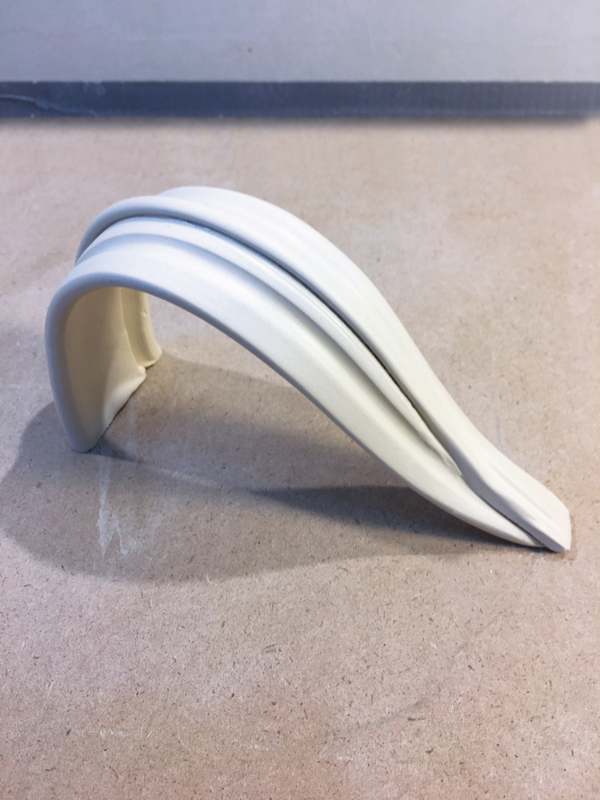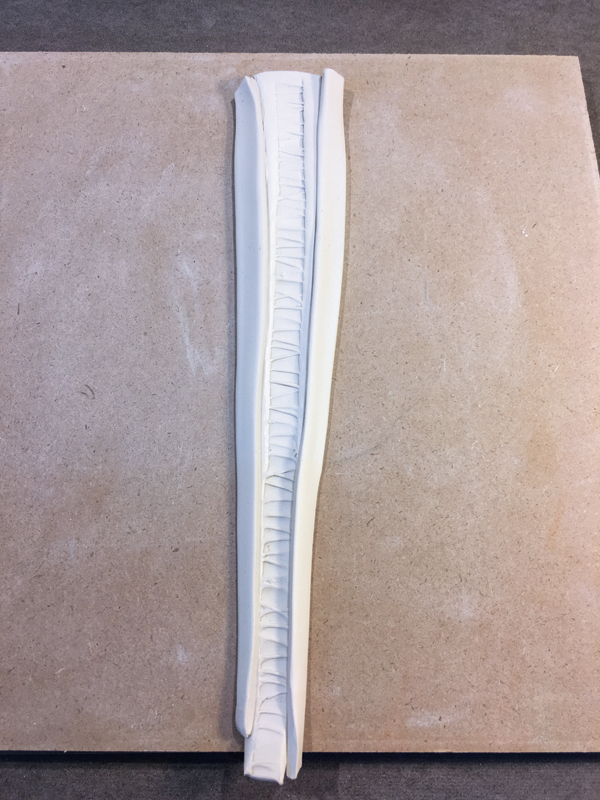
There are a lot of different ways of making pottery handles—from pulling handles for mugs to Gail Kendall’s fun handbuilt handles. When Marion Angelica switched from wheel throwing to hand building, she needed to reconsider how she approached handles. The traditional pulled handle did not seem to fit her modular slab built pots.
So she started experimenting. In today’s post, an excerpt from the Pottery Making Illustrated archive, Marion shares a couple of her fun techniques for making pottery handles. – Jennifer Poellot Harnetty, editor
When I switched to handbuilding from wheel throwing, I had to rethink how to make handles that best reflected the feel of my handbuilt work, so I began exploring. A few times a year, I set aside a play day in the studio that I devote to non-productivity, making different types of knobs or handles, and manipulating clay to see what forms or textures result. So far, something new, unexpected, and applicable to my work has always been the outcome. The four different handles I now make are the result of a studio play day.
The Basic Rolled Handle
Using a slab roller or a rolling pin, create a ½-inch-thick slab that is approximately 5 inches long and about 8 inches wide. (Check out this post in the archives on a great DIY slab roller. The slab’s width depends on how many handles you plan to make. A 5×8-inch slab will yield 6 to 8 handles for cups. For larger items such as pitchers or baskets, make the slab proportionally bigger.
Smooth and compress the slab on both sides with a hard rib. Using a ruler, cut an elongated triangle 5 inches long and ¾ inch wide at the top (1A). You can modify these measurements as you determine the proportion of the handle you want for a given vessel.
With your fingers, round and compress the edges of the triangle. Flip the piece over and repeat on the other side.



Starting at the wide end of the triangle, apply light pressure with a rolling pin and increase the pressure as you roll down the triangle to its tip (2A). Flip the triangle over and repeat. Do this a few times until the tapered triangle feels as thin as you would like the handle to be. This maneuver may require a few practice rolls to get the knack of increasing the pressure evenly. The goal is to have the handle thicker at the wide end and thinner at the narrow end (3A). As you roll the triangle, it will both elongate and widen. If the handle becomes too wide, either use a ruler as a guide to cut off the edges or start with a thinner triangle when you cut it from the slab. If you trim it, be sure to smooth and round the edges or they will
be sharp when fired.
The Cut Handle
The basic rolled handle technique can be used to create many variations. The following pages describe two of the variations I’m currently using: the cut handle and the overlaid handle. There are three benefits to a cut handle.
The first is that it gives a vessel a unique look; the second is that it provides excellent leverage, especially for larger cups or pitchers, and lastly; it eliminates the tension that can pull the handle’s tail away from the vessel during drying.
To make a cut handle, follow all the steps for the basic rolled handle but stop after using the dowel to make the connection point look organic (see image 6). Lay the handle on the table with the tail end toward you. Then using a long, sharp blade, cut straight across the handle with the blade held at approximately a 45° angle toward the wide end of the handle (that will be away from you) (1B). For a cup, make the cut 1 to 1¼ inch from the wide end of the handle.
For a pitcher, make the cut between 1½ to 2 inches from the wide end. Next, place your blade in the same location as the first cut, angle the blade edge 45° toward the narrow end and cut again. Gently separate the two parts of the handle. A small 90° wedge will be left on the table (2B). Discard this small wedge.




Carefully score each cut and, with a little slip, gently pinch the two pieces back together (3B), being careful not to distort the clay. Lay the handle on its side until it firms up to soft leather hard. You can shape the two parts with curves while it’s on its side. I tend to put a light concave curve into the short (top) piece to fit a person’s thumb comfortably. Then score and add slip to attach the handle to your vessel (4B). If you choose to blend the seam, do this using your finger or a tool when the handle has set up to leather hard.
The Overlaid Handle
As you did before, cut a long triangular piece from a ½-inch-thick slab. Make this triangle wider than you want the handle to be. Compress the sides and edges of the triangle and use the rolling pin to shape the handle from thick at the top to thin at the tail. These are the same steps you followed with the basic rolled and cut handles. The difference comes at the next steps.
Using a sharp knife and a ruler, cut the triangle down its length and separate the two long pieces. I often make this cut uneven so that one piece is wider than the other (1C).




Compress the cut edges of the two pieces with your fingers by sliding them along the length of each piece. Decide which piece you would like to overlay the other. In general, I select the wider length to go underneath. Run your finger along the inner edge to create a softly beveled angle on this piece. Lightly score this bevel.
Brush the scored area with a little thin slip or water (you don’t want it to ooze out) and lay the second length over the scored area. Then, using mild pressure, slide a finger along the top piece at a 30–45° angle facing the center of the handle to adhere the two pieces (2C). This will leave a decorative ridge along the handle. Once the two lengths are reconnected, follow the same steps used in making the rolled handle (3C).






